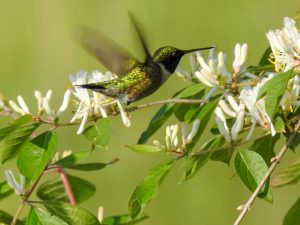
There’s nothing quite as exciting as catching a glimpse of the tiny, iridescent, Ruby-throated Hummingbird in your garden. These extremely migratory birds are not only beautiful to watch, but also play an important role in our ecosystem.
In the spring in central Ohio, Ruby-throated Hummingbirds make their way back to our gardens and backyards to mate, build nests and raise young. They can travel as far south as South America, again in the fall. These small birds are considered the ‘helicopters’ of their world. In contrast to other birds, the hummingbird wing is free to rotate in all directions at the shoulder because of its ball-and-socket joint (unique to hummingbirds and swifts). Hummingbird wings can beat up 50- 80 times per second. This may explain why they seem so magical because most of the time, you only see a blur of wing movement as they float through the air. Hummingbirds have good eyesight with large eyes strategically located on either side of their head, which allows them to spot a broad spectrum of colors and predators quickly. They are mostly attracted to red, but they will visit other colored flowers.
Ruby-throated Hummingbirds can eat flies and spiders, particularly during migration, but their main source of energy comes from nectar. They have long, narrow black beaks which aid them in collecting their main food source. Inside the beak, they have a very long tongue used to lap up nectar inside a flower. A voracious appetite allows them to consume up to half their body weight in nectar every day. This would be like a 200 lb. person drinking approximately 12 gallons of water each day. Because these little birds spend a majority of their days visiting flowers, they also become excellent pollinators. When the hummingbird puts its beak into the flower (to lap up the nectar), pollen gets stuck on its head and wings. Then, when they move to another flower some of that pollen drops off into that next flower.
In order to attract these flying jewels to your garden, all you need is appropriate food, water and shelter building sources for them. These birds build their nests out of spider webs and lichen. It’s a great reason not to wash your windows this spring; it will give the hummingbirds a place to glean some fresh webs. Having a water source is also helpful. The tubular shaped flower assists in the hummingbird’s choice for choosing which flower to visit. However, the shape is not the only determinant to how the bird chooses a flower. Hummingbirds have been known to visit other colorful, more open blooms, with both large and small petals. Because hummingbirds can hover in the air while retrieving nectar, they don’t require large landing strip petals like butterflies. They also don’t need the colorful nectar guides which can be helpful for many bees. Their long beaks allow them to utilize flowers with nectar found deep inside the inflorescence. The list accompanying this article contains plants that will assist in attracting hummingbirds to your garden. The plants listed can also all be found at Inniswood Metro Garden. (By Cindy Maravich,Senior Environmental Educator at Inniswood Metro Gardens)
Adults and Seniors are invited to join us at Inniswood this Sunday, May 22 at 2pm for a Metro Five-0: Gardening for Hummingbirds program!
Perennials
Gayfeather, Liatris spicata
Cardinal flower, Lobelia speciosa
Foxglove, Digitalis purpurea
Culinary Sage, Salvia purpurea
Yarrow, Achillea sp.
Bee balm, Monarda sp.
Wild columbine, Aquilegia canadensis
Daylily, Hemerocallis sp.
Coral bells, Heuchera sp.
Tickseed, Coreopsis sp.
Coneflower, Echinacea
Garden phlox, Phlox paniculata
Beardtongue, Penstemon
Peony
Catmint, Nepeta sp.
Lily, Lilium
Iris
Red hot poker, Kniphofia
Bugleweed, Ajuga
Black-eyed Susan, Rudbeckia
Annuals
Flowering tobacco, Nicotiana alata
Sage, Salvia sp.
Mexican sunflower, Tithonia
Anise hyssop, Agastache sp.
Impatiens
Petunia
Spider flower, Cleome sp.
Blue vervain, Verbena sp.
Summer snapdragon, Angelonia sp.
Begonia
Snapdragon, Antirrhinum majus
Pinks, Dianthus sp.
Marigold, Tagetes sp.
Lantana
Sweet Alyssum, Lobularia maritima
Dahlia
Cypress vine, Ipomoea quamoclit
Cardinal climber, Impomoea sloteri
Mandevilla
Shrubs
Butterfly bush, Buddleia sp.
Viburnum sp.
Spirea
Summersweet, Clethra sp.
Hydrangea
